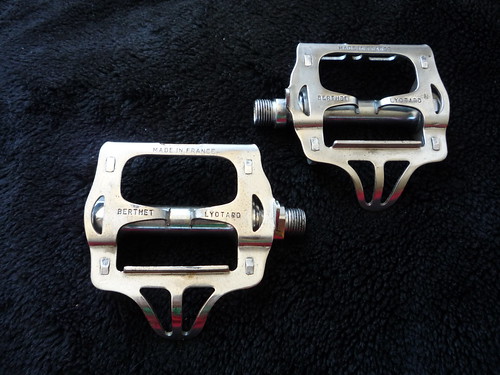If you shop at Velo Orange, as I do, you've seen their stitched-on elkhide handlebar covers. They're offered in lengths for dropped as well as upright bars.
Chris at Velo Orange insists they're wide enough to fit around both the bar and cable. You would need that with if you're using aero or inverse brake levers.
I believe him, but I decided against installing those covers because when I have to replace my cables, I'd have to unstitch the covers. Knowing myself, I'd probably break the thread or do something that would make it impossible to re-install the covers.
However, back in the day, I did have stitched-on grips at various times on a couple of bikes. Of course, in those days, I also wasn't riding aero levers and inverse levers were all but unavailable. That meant riding "traditional" levers, with exposed cable housings. To replace them, it wasn't necessary to remove the tape or coverings from the handlebar.
As I recall, two companies made stitched-on bar covers: Cannondale and Rhode Gear, both of which still did all of their manufacturing in the US. For all I know, both companies' handlebar covers may have been made in the same factory and were simply marketed by one company or the other. I say that because I used both and don't remember any difference, except perhaps in the choice of available colors, between them.
Anyway, it was interesting to see a red Rhode Gear set on eBay. It was maybe a shade lighter than oxblood, a color I've always loved on leather. (I once had a jacket and a pair of penny loafers in that shade.) I installed the covers on my Trek 930 after I tore up a few other tapes, and they lasted until I sold the bike. More important (!), they looked great on the bike, which was black. Actually, before I sold the bike, I spent I-don't-know-how-long unstitching the covers, which I replaced with Benotto or some other cheap tape. The pretty red handlebar covers went went to my Cannondale (Don't tell anybody!) race bike.
Of course, even if I were going to install stitched-on leather covers, I wouldn't buy those old ones, as much as I like the color. I've already mentioned one reason: cable replacement. On a related issue, I'm not sure that a 30+-year-old leather cover would fit around a bar and cable. And, finally, if old leather hasn't been stored or cared-for properly, it will disintegrate with use.
That is, if I were actually going to ride the bike. Now if I wanted to build a "time capsule" bike, circa 1985, I just might consider those grips. Then again, would I want to pay $120 when VO sells theirs for $35?
| Velo Orange stitched-on bar covers |
Chris at Velo Orange insists they're wide enough to fit around both the bar and cable. You would need that with if you're using aero or inverse brake levers.
I believe him, but I decided against installing those covers because when I have to replace my cables, I'd have to unstitch the covers. Knowing myself, I'd probably break the thread or do something that would make it impossible to re-install the covers.
However, back in the day, I did have stitched-on grips at various times on a couple of bikes. Of course, in those days, I also wasn't riding aero levers and inverse levers were all but unavailable. That meant riding "traditional" levers, with exposed cable housings. To replace them, it wasn't necessary to remove the tape or coverings from the handlebar.
As I recall, two companies made stitched-on bar covers: Cannondale and Rhode Gear, both of which still did all of their manufacturing in the US. For all I know, both companies' handlebar covers may have been made in the same factory and were simply marketed by one company or the other. I say that because I used both and don't remember any difference, except perhaps in the choice of available colors, between them.
| Rhode Gear stitched-on handlebar covers, red, circa 1985 |
Anyway, it was interesting to see a red Rhode Gear set on eBay. It was maybe a shade lighter than oxblood, a color I've always loved on leather. (I once had a jacket and a pair of penny loafers in that shade.) I installed the covers on my Trek 930 after I tore up a few other tapes, and they lasted until I sold the bike. More important (!), they looked great on the bike, which was black. Actually, before I sold the bike, I spent I-don't-know-how-long unstitching the covers, which I replaced with Benotto or some other cheap tape. The pretty red handlebar covers went went to my Cannondale (Don't tell anybody!) race bike.
Of course, even if I were going to install stitched-on leather covers, I wouldn't buy those old ones, as much as I like the color. I've already mentioned one reason: cable replacement. On a related issue, I'm not sure that a 30+-year-old leather cover would fit around a bar and cable. And, finally, if old leather hasn't been stored or cared-for properly, it will disintegrate with use.
That is, if I were actually going to ride the bike. Now if I wanted to build a "time capsule" bike, circa 1985, I just might consider those grips. Then again, would I want to pay $120 when VO sells theirs for $35?

